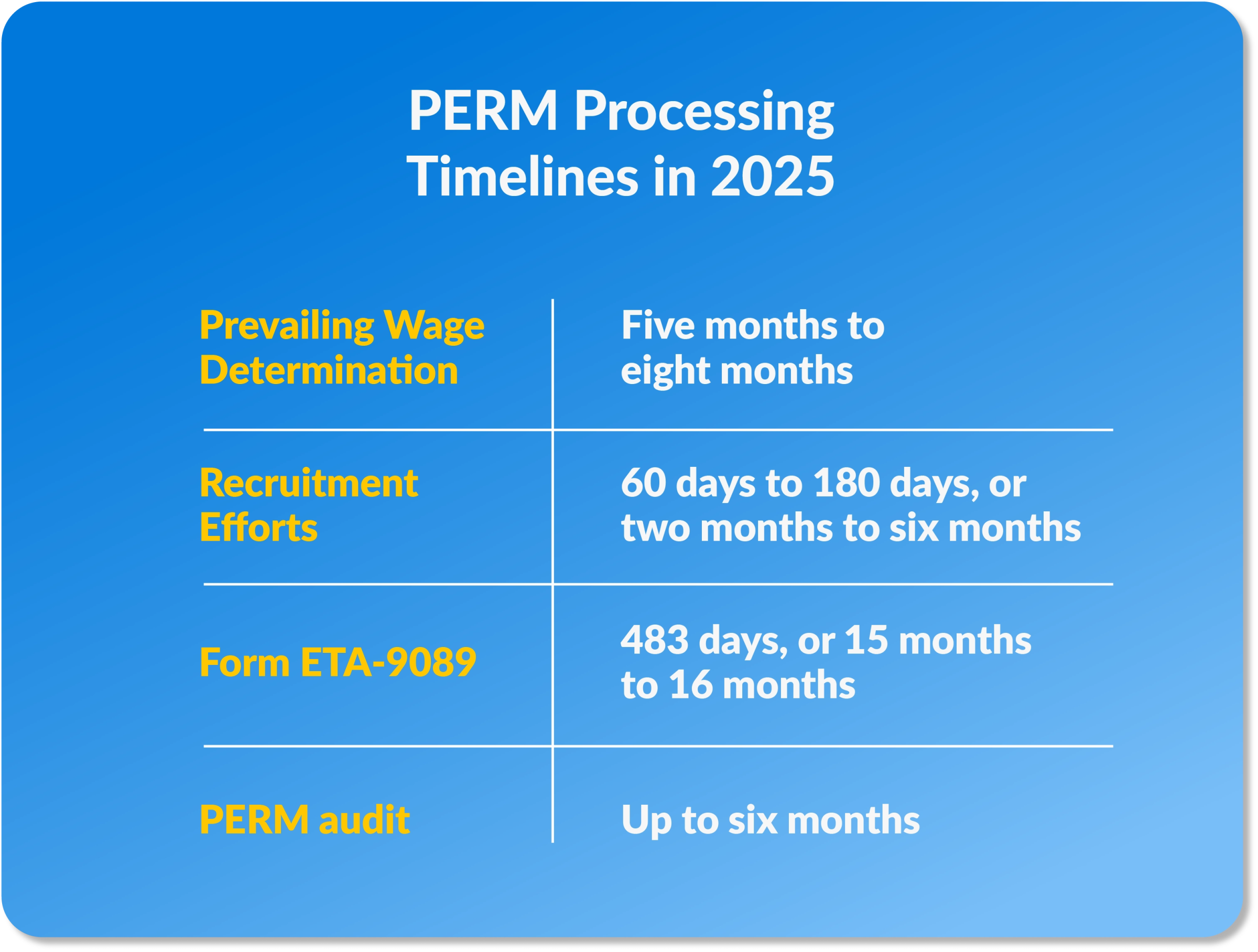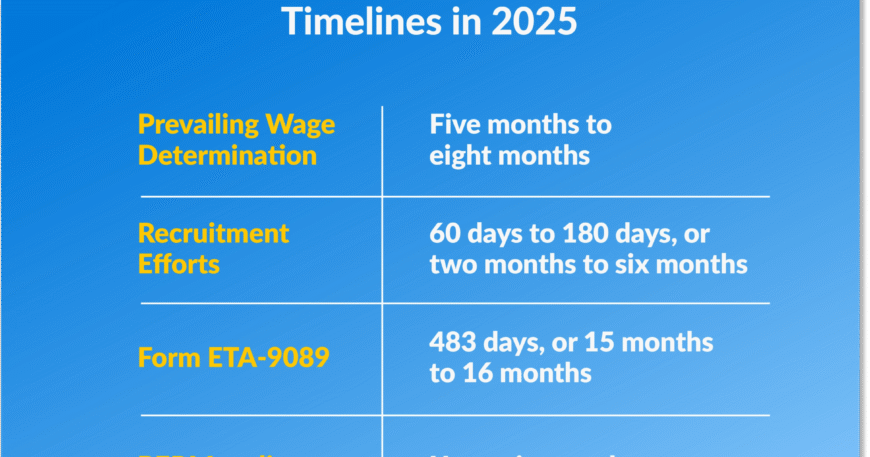Introduction
The PERM processing time is one of the biggest sources of frustration and uncertainty for employers and foreign professionals navigating employment‑based green card pathways. It’s often unpredictable, long, and subject to delays. But with the right understanding and planning, you can anticipate bottlenecks and apply strategies to reduce unnecessary waits.
In this post, we explore what typical PERM processing time looks like in 2025, why delays happen, how audits and prevailing wage steps add to it, and 9 actionable tips to shorten your timeline. We’ll also embed the phrase processing time 20–30 times to help this content rank and be easy for readers to find.
What Is “PERM Processing Time”?
When we say PERM processing time, we refer to the total duration from when an employer submits the ETA Form 9089 to the Department of Labor (DOL) until the labor certification is approved (or denied). That doesn’t include the steps before (like prevailing wage or recruitment) or after (like filing I-140 or adjustment of status). But in practice, the total effective wait from start to green card often is heavily influenced by the processing time.
Because many people talk loosely about “how long until green card,” confusion arises. But for clarity:
-
PERM processing time (core): Submission → DOL decision
-
Full employment‑based timeline: Prevailing wage → PERM → I-140 → visa availability → I-485 or consular processing
In this article, wherever we refer to processing time, we mean the DOL adjudication part, but we also discuss how it affects the broader timeline.

Current Benchmarks: How Long Is PERM Processing Time in 2025?
The PERM process has experienced lengthening backlogs in recent years. Let’s look at what the data says:
-
In recent reports, processing time (for non‑audit cases) averages about 496–499 calendar days (roughly 16 months).
-
Some firms and law practices observe DOL adjudications in the 472‑day range (about 15.5 months) in 2025.
-
Older data showed averages closer to 439 days (~14+ months) for non‑audit cases.
-
For audit cases, the processing time can be much longer—adding 6 to 12+ months or more.
-
Some sources estimate that the entire PERM process (including recruitment, wage determination, filing) can stretch to 22 to 36 months.
So yes, processing time is a serious waiting game right now.
Why PERM Processing Time Is So Long: Key Delay Factors
1. Prevailing Wage Determination (PWD) Bottlenecks
Before the PERM can even be filed, the employer must secure a prevailing wage determination (PWD) from the National Prevailing Wage Center (NPWC). Delays here feed directly into your processing time because you can’t file the PERM until the wage is approved.
Currently, PWDs are taking 4–8 months or more, depending on whether they involve private wage surveys or revisions.
2. Recruitment and Advertising Requirements
The PERM rules require the employer to undertake recruitment activities (ads, notices, official postings) for a defined duration before filing. This recruitment phase often takes 2 to 3 months, and any missteps in the documentation (timing, placement, records) can cause objections or delays that inflate processing time.
3. DOL Backlogs & Resource Constraints
The DOL (Office of Foreign Labor Certification) is under pressure with increasing numbers of filings and limited resources. The backlog means that they are processing older applications first (by “processing month” rather than strictly first‑in, first‑out), which can cause applications filed early in a month to wait longer.
Also, the DOL sometimes pauses or delays processing due to funding, staffing, or system maintenance.
4. Audits
One of the most unpredictable drivers of extended processing time is the audit process. DOL selects a portion of applications for audit (around 20–25% historically) to verify compliance with recruitment steps, wage determinations, and recordkeeping.
If audited, you may receive a Request for Audit, demand for additional documentation, supplementary reviews, and responses. The audit itself can add 6 to 12+ months (or more) to your processing time.
5. Reconsideration or Appeals
If the PERM application is denied or has discretionary issues, you may need to file for reconsideration or appeal (through BALCA). That further adds months to processing time.
6. Errors, Omissions, or Incomplete Filings
Even minor errors in form ETA 9089, inconsistencies in job descriptions, missing documentation, or recruitment missteps can lead to additional scrutiny by DOL, resubmissions, or delays, which push up processing time.
7. System or Regulatory Changes
The DOL has transitioned from legacy PERM systems to the FLAG system (Foreign Labor Application Gateway), which has introduced new rules and structural changes. These transitions sometimes cause delays or rework that indirectly increase processing time.
How PERM Processing Time Affects the Overall Green Card Timeline
Your processing time is not just an isolated step—it has ripple effects:
-
Until PERM is certified, you cannot file the I-140 immigrant petition (in most EB-2/EB-3 cases).
-
Delays in PERM push back your priority date and cause “visa bulletin” waiting periods to stretch.
-
For those on H-1B visas, long processing time can jeopardize strategy when reaching 6‑year limits, requiring extensions or fallback plans.
-
Dependent family members (spouse, children) must wait until your I-485 or consular appointment, so delays in PERM delay their status too.
In short, processing time is a bottleneck that often determines the pace of your entire employment‑based green card journey.
9 Actionable Tips to Reduce Your PERM Processing Time
Let’s dive into proven strategies to manage, mitigate, and sometimes shorten your processing time.
1. Start Early — Don’t Wait to File PWD
Because the prevailing wage step can take months, file it as soon as possible. If you delay this, your processing time is going to be delayed from the start.
2. Choose Job Descriptions Wisely
Use job titles, descriptions, and requirements carefully so they are not overly narrow or requiring niche credentials that invite scrutiny. This reduces risk of DOL questions and audit, which can inflate processing time.
3. Meticulous Recruitment Documentation
Follow the recruitment rules exactly: job ads, postings, records, resumes, interview logs, rejection justifications. Strong documentation helps defend your application if audited, reducing the likelihood of audit‑induced delays.
4. Error‑Proof Your ETA 9089 Submission
Before submitting, perform internal audits: check all fields, consistency, logic, no typos. Prevent avoidable “fix and resubmit” steps that increase perm processing time.
5. Use Experienced Counsel or Specialists
Experienced immigration attorneys or firms know the common pitfalls, DOL expectations, audit triggers, and structuring that can minimize time spent in review or follow‑up that lengthens processing time.
6. Be Audit‑Ready from Day One
Maintain records, copies of job postings, internal memos, and evidence of recruitment decisions. If DOL asks, you can respond quickly and comprehensively—which helps contain the extension to processing time.
7. Monitor DOL Updates & Processing Trends
Keep your attorney or HR team attuned to DOL updates (e.g. FLAG changes, processing month shifts). Reacting early to changes helps you adapt and avoid surprises that prolong perm processing time.
8. Consider Reconciliation or Appeal Strategy Ahead of Time
If your PERM is likely to face a challenge, plan for reconsideration or appeal in advance. Having documentation ready can save weeks or months in perm processing time later.
9. Explore Alternative Green Card Paths
If perm processing time is unbearably long, evaluate options that skip PERM or rely on different qualification criteria—such as EB‑1 (extraordinary ability) or EB‑2 NIW (National Interest Waiver) which may avoid the PERM step entirely.
When PERM is skipped, you bypass that major waiting period altogether.
Sample PERM Timeline (with & without Audit)
| Step | Typical Duration (Normal Case) | With Audit / Delays | Cumulative “Perm Processing Time” Impact |
|---|---|---|---|
| Prevailing Wage Determination | 4‑8 months | +2–4 months | + months before even filing |
| Recruitment Phase | 2–3 months | + weeks if issues | delays before filing |
| DOL Review / Adjudication | ~15–16 months | + 6–12+ months | This is your core perm processing time |
| Audit Response / Supplement | — | + 2–6 months or more | Added to core time |
| Appeal / Reconsideration | — | + 3–9 months+ | Further extension |
Thus, in many real cases, the perm processing time may stretch 20 months or more from the filing date, especially if audits or appeals are involved.
Hypothetical Scenario: Alice’s PERM Journey
Alice’s employer filed her PWD in June 2024 (took 5 months). Recruitment began in November 2024 (2 months) and the PERM application was submitted in January 2025. The DOL is reviewing applications filed in June 2024 in October 2025, which corresponds to about 15 months of processing. Alice’s PERM is audited, adding 8 more months, meaning her total perm processing time from submission to certification approaches ~23 months.
Had her application avoided audit, she might have seen certification in ~15–16 months.
This example illustrates how perm processing time swings widely depending on audit and filing timing.
How to Check and Monitor Your PERM Processing Time
-
The DOL publishes its processing time (“processing month”) on its FLAG or OFLC portal.
-
Your attorney or your employer (through the PLC/DOL system) can track when your application enters the processing month window.
-
Compare your filing date to current processing months to estimate rough perm processing time.
-
Monitor public forums (e.g. H‑1B/immigration threads) to see what others filing in your month are experiencing.
-
Stay in communication with counsel to flag any changes or anomalies.
Common Myths & Misconceptions About PERM Processing Time
-
Myth: Premium processing exists for PERM.
Truth: There is no premium processing for PERM. You must go through standard adjudication. -
Myth: All PERM cases take exactly 16 months.
Truth: That’s an average benchmark. Some cases finish in ~12 months, others take 24+ months. Audit status, employer diligence, and filing timing all matter. -
Myth: Changing job titles mid‑case shortens perm processing time.
Truth: That usually resets evaluation or invites greater scrutiny, often increasing time, not decreasing it. -
Myth: Once past 12 months, you can demand DOL act.
Truth: There is no guarantee or legal requirement for faster processing after a threshold, though some litigations or requests may help in specific cases.
Outlook & Trends: Will PERM Processing Time Improve?
Some encouraging signs:
-
Some law firms report slight reductions in PWD delays (e.g. 4 months average PWDs compared to previous 6 months).
-
Slight dips in average PERM days in certain months suggest modest improvements in some windows.
Still, systemic pressure, rising filings, and retrospective audits suggest perm processing time will likely remain long for the foreseeable future. Businesses and applicants should plan accordingly and not count on dramatic speed-ups anytime soon.
Summary & Key Takeaways
-
Perm processing time for non‑audit cases currently averages ~15 to 16 months, and can stretch to 20+ months or more when audits or appeals intervene.
-
Before PERM, delays in the Prevailing Wage Determination or recruitment phase already eat weeks or months.
-
Audit selection is the single biggest wildcard in inflating perm processing time.
-
You can take steps—thorough preparation, error avoidance, audit‑ready documentation, experienced counsel—to reduce avoidable delays and shorten perm processing time.
-
If the wait is unbearable, evaluate alternate green card paths that skip PERM (like EB‑1, EB‑2 NIW).




